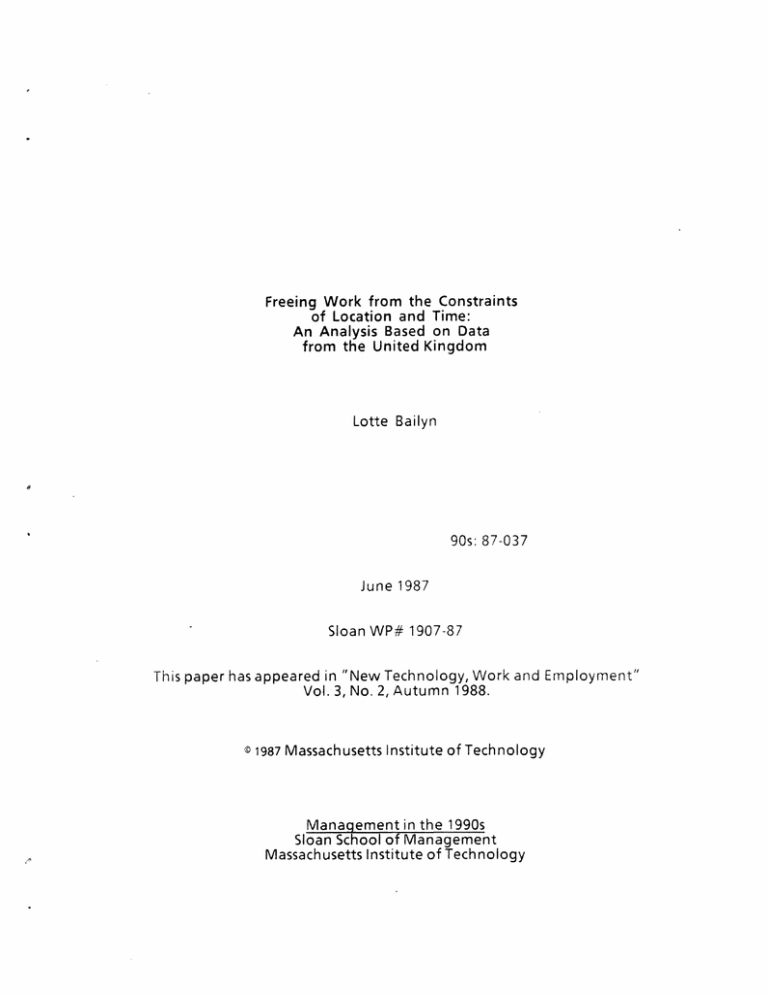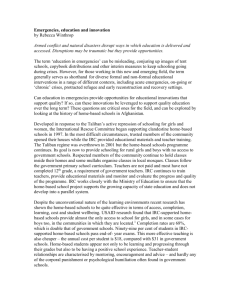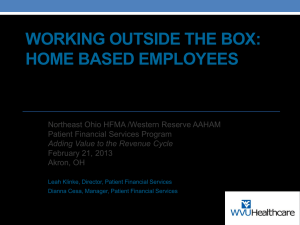Freeing Work from the Constraints
advertisement

Freeing Work from the Constraints of Location and Time: An Analysis Based on Data from the United Kingdom Lotte Bailyn 90s: 87-037 June 1987 Sloan WP# 1907-87 This paper has appeared in "New Technology, Work and Employment" Vol. 3, No. 2, Autumn 1988. I 1987 Massachusetts Institute of Technology Manaqement in the 1990s Sloan School of Management Massachusetts Institute of Technology Management in the 1990s Management in the 1990s is an industry and governmental agency supported research program. Its aim is to develop a better understanding of the managerial issues of the 1990s and how to deal most effectively with them, particularly as these issues revolve around anticipated advances in Information Technology. Assisting the work of the Sloan School scholars with financial support and as working partners in research are: American Express Company BellSouth Corporation British Petroleum Company, p.l.c. CIGNA Corporation Digital Equipment Corporation Eastman Kodak Company Ernst & Young General Motors Corporation International Computers Ltd. MCI Communications Corporation United States Army United States Internal Revenue Service The conclusions or opinions expressed in this paper are those of the author(s) and do not necessarily reflect the opinion of the Massachussetts Institute of Technology, the Management in the 1990s Research Program, or its sponsoring organizations. Acknowledgements This paper is based on information collected in the United Kingdom in 1986-7. It is part of a collaborative project with Dr. Constance Perin, Principal Research Associate, Management in the 1990s, on information technology and the home/office pattern of work. The work is supported by funds from the Management in the 1990s Program of MIT's Sloan School of Management. Freeing Work from the Constraints of Location and Time Information technology is making possible new patterns of work, with greater flexibility in location and time. But traditional assumptions about the requirements of coordination and control serve as a strong deterrent to their implementation. This paper deals with these possibilities and with their limits; it does so by means of data collected in Britain at a number of sites, with different populations, and by a variety of means. Having to work in a particular location - the office - over a particular period of time - the office day - is a key feature of the way industrial work has been organized for over two centuries. This mode of working has many obvious advantages: for individuals: 'it structures their time 'it gives them social contact 'it gives them a sense of achievement, of worth, of identity for the organization: 'it permits control and coordination of work 'it makes employees visible - hence they can be guided, evaluated, and developed 'it mandates the interaction necessary to secure consensus on organizational goals It represents a traditional, stable structure, to which we have become accustomed. constraints imposed? So why talk about its negative aspects, the Most generally, because there is a feeling that the way we traditionally have managed work is no longer doing the job as well as current conditions seem to require. More specifically, because in a world of multinational corporations and global markets, -2- distance and time have taken on different meanings. An office day in one part of the world is private time elsewhere, but the communication between them can now be instantaneous. This realization hit with a bang, a big bang, at the London stock exchange last October: The task was to come up with a system that would make the London market competitive in a world where technology had eliminated geographic distance as a factor, and where markets in different time zones and different countries competed directly.l The new importance of time is also attested to by analysts in the field of time geography. One of these, Murray Melbin, has called time the last big frontier and talks about the colonization of time: The last great frontier of human migration is occurring in time - a spreading of wakeful activity throughout the twenty-four hours of the day. 2 And, with the advent of new techn ology, loc atio n too is becom ing more and more irrelevant, at the same time as it is becoming more of a problem because of the expense of central c ity offices and the toll of commuting - both for people an d for the envi ronment. Hence it is important to cons ider what is i nvolved in ext ending the boundaries of work beyond the office. Spec ifically, I wa nt to consider the extension into the h ome, a sub ject that has gott en a great deal of attention lately. It is vari ous 1 y called telecommuting, telework, distance working, flex iplace. futurists have predicted that by the end of the Some 1990s one-thi rd to one-half of all people will be wo rking from hom e, half of the se with computers. And though I doubt whether thes e predictions will come true - previous ones have not - still, working from home as part of 1 D.N. Thompson, Big bang: The cit y revolution begins. Quarterly, 51(3), 1986, p. 79. 2 M. Melbin, The colonization of t ime. In T. Carlstein, D. Parkes, and N. Thrift (eds.), Human acti vity and time geography, New York: Wiley, 1978, p. 100. Busi.ness -3- a company organization is an important phenomenon, which needs to be taken seriously. For one thing, it is here to stay, in some form and to some extent, and the e vidence we have indicates that it can play an important role in maki ng work more productive. Further, there has been a great deal of publ icity and much glib talk about pros and cons, but very little cri tical empirical investigation. Finally, by analyzing the resistance to this pattern of work - and there is lots of it, by bot h the peop le potentially involved and their managers we can learn much about t raditional managerial processes, which may in any case bDe useful. The strat egy of our research into this pattern of work has been to study livi ng cases in some detail and to limit the investigation to a particul ar part of the work force. We have concentrated on higher level, higher pa id personnel - in the technical, managerial, professional levels of organizations. The issues they present are very differen it from tho se confronting lower level, clerical workers involved in dlata entry or word processing, and some of the confusion in the discus;sion of wo)rking from home has resulted from not clearly differentiati ng these t wo types of employees. The employees we study are an increasing part of the work force, and also represent its highest cost. They are the ones who deal with the nonroutine, unstructured tasks in organizations. In them, therefore, resides the flexibility necessary for organizational adaptability to an ever increasing rate of change. And so, we deal with high level personnel. Almost by definition the work they do cannot be done in full isolation, and so we are NOT dealing with people who are always at home. In fact, one of the first things we found when we began was that employees of -4- F-International, a well known home-based software development house in the UK, and the home-based contract programming unit of ICL, normally spend anywhere from 20% to 70% of their time away from their homes. So they are not always at home, but they are also not office- based workers who do overtime or oveflow work at home. All of us spend some evenings and weekends working at home, many with computers with or without links to the office. This pattern creates no problems, at least not for the organization - the perspective of the family is another matter. In fact, a number of American companies have assisted their employees in buying computers at home to pursue their work, but made their help conditional on those employees still spending the normal working hours in the office. pattern is not the focus of our study. This overflow Rather, we are interested in the office/home pattern, where people spend some of the regular work week working at home; a partial substitution of work at home for office-based work, not an addition to it. It is this pattern, we believe, whose increase has the potential to benefit both individuals and organizations. require changes in managerial processes. But to do so will It is our thesis that such changes are necessary in any case if organizations are to become more adaptable: to accommodate new kinds of people in the work force, to deal with rapidly changing demands. In order to investigate these issues we have looked at home-based work forces and compared them to office-based workers doing the same kinds of tasks; and we have looked at employees who have traditionally not worked in an office - i.e. field forces - some of whom may have an office base, others of whom are based in their homes - or in their cars. -5- Before giving the details of the two British study sites, however, I would like to present the case of Rank Xerox, whose experiment in network ing represents one successful way of using information i technolog y in a reorganization of work location and employee re.lations. Rank Xerox: An Example of the Spin-Off Pattern 3 - Rank Xerox started their networking experiment in 1982. It was motivated primarily by the high expense of London office costs. figured that for an employee earning 10,000 in salary, their actual outlay, including a 11 benefits and office costs, was that this extra 27,000, and £17 ,000 was non-productive expenditure. not the only motiva tion. They But cost was They also believed that they could motivate some of their high level people better if they made them more independent, and, s ince the technology of linking micros to central mainframes was avai lable relatively inexpensively, they felt the time was ripe for their experiment. They closed one of their buildings, and over the next four years sent about 5% (50 men and 6 wome n) of their central office staff out into the w orld as independent businesses. These people are not only in compute r systems development, but in many other fields, including marketing, market research, busi ness planning, finance, legal, tax, personnel (recruitment, safety, security, pensions), PR. What is common to them is that they are all information workers from 3 The information presented here stems from P. Judkins, D. West, and J. Drew, Networking in orqanisations: The Rank Xerox experiment, A-d-ershoot: ower, 9-T P. Judkins, Towards new patterns of work - the Rank Xerox networking experiment, European Management Journal, 4, 1986, 192-196; D. Homby, Can we teach ourselves to change? The Royal Bank of Scotland Review, September 1986, 14-21; and some-informal discussions with the people involved. III -6- manageria 1 or professional executive jobs in t he company and that they work on tasks in an output mode What th is means is that the organizat ion's concern is only with the output of their jobs, in contrast to employees who work in a continuity mode, where physical presence is necessary for fulfilling tasks. The c Iompany was very careful abo ut its ini tial selection of networker s. Not only were the tasks carefully scrutinized, but so too were the people. Choices were based, in part, on personal ity tests and the companiy refused to take anyo ne with high social needs. Having made their seelection, they then hel ped these people set up their own companies: they provided them wi th the computer equi pment they need ed, trained them in sales techniq ues, taxation, and o ther issues of small busi nesses, counseled them and their families on the problems associated with an office at home (they even had outs ide consultants des ign various alternati ve hom e set-ups), and cont racted for their servi ces up to 50% of thei r tota 1 output. Of particul ar importance is the compan,y 's claim that this 50% is equivalent to the fulltime services of these people when they were office-based. They attribute this to three factors. First, the productivity of the networkers increased when they were working on their own and for themselves. techniques were improved. Second, and more important, management It was now necessary for managers of the networkers to make closer specifications of need and to think more precisely about the quality and time standards that the work required. Finally, there was an increase in productivity of core support staff who took over some of the continuity tasks of the networkers,.and thus had to get equipment and training - all of which led to higher motivation and self-management. -7- Rank Xerox identified two kinds of people they considered most eligible for networking. The first was an entrepreneurial type who wanted a full time business with clients. The second was a person who only wanted to network for 50% of his or her time, in order to do something else. People considered not eligible were those who were too social or did not have enough self-direction, as well as employees singled out for movement up the Rank Xerox hierarchy. This last criterion created some interesting dynamics: some people wanted to network but were turned down because they were considered to have too much management potential. The company sees networking as one of a number of experiments on new relations to work, and report that not one has so far failed. Their biggest mistake, they feel, was that they concentrated too much on networkers and not enough on the core staff left behind - both support and management, particularly the latter. These managers needed new skills in managing output, managing for time and quality, designing and scheduling of work, setting quality standards, and broking and purchasing. They had to learn not to be concerned with how things are done, but merely with the output. This management style has now permeated the whole organization, and is no longer so much of an issue in relation to networkers. This, then, is the spin-off pattern: separating employees from the parent company and contracting with them to buy their services. Home-Based Programming Service of a Computer Company A different pattern is the integrated pattern, exemplifed by the home-based programming service of a British computer company. This program was started in the late 'sixties as a way of allowing women II 8- with scarce computer skills to continue to serve the company parttime, and to k eep up t heir skills and their involvement with work, while at the s ame time raising a f amily. Initially they formed an hourly work force with no employme nt benefits and did mainly bodyshop work, tak ing bits of programm ing home to finish in isolation. This part of t he compa ny has now b een turned into a business unit in its own right and is m aking a prof it. It is managed by a fulltime home-based man ager, ha s its own career structure with both a management and a techn ical t rack, and is involved in a variety of projects devel oping systems for both internal and external applications. The wor kforce is st ill paid by the hour (though this is not true of its man agers) , but they are now eligible for most employee benef its. Th e unit has a pproximately 120 people in it, including its manageme nt, wi th abo ut 30 technical authors. It is still mainly f emale, though they n ow have a number of men, primarily in the second Rank Xerox category, those interested in other activities or in a particular location of t he country. At this site we were able to study in d etail the differences between this w ork force and those employees doing offic e-based systems develo pment. We targeted 55 people clearly in systems development in the home-based unit, and 51 systems deve lopers who were office-ba sed. This latter group consi sted of both employees and contractors, b ut all were working at compan y office sit es. We sent everyone in each of these groups a detailed questionnai re, based on intensive pre-test interviews, in order to discover whether they did their tasks differently and whether they related differently to their work. The response rate was good (89% of the home-based group; 78% of those office-based), and the results can be summarized in the following points: -9- 1. There are basic demographic differences between the groups. The home-based unit is primarily female, the office based unit more heavily male. Further, most of the home-based ("off-site") people are working parttime. They typically start at 16 hours/ week (which is the minimum legally for an employee) and slowly increase until they reach 37 hours/week (fulltime). The predominantly parttime aspect of their work is seen as problematic by many company managers, even though their on-site people often spend only part of their time on a given project. 2. The home-based work force is older and more experienced. They have a mean of almost 15 years computer experience compared with less than 10 for office-based employees. This difference in experience probably reflects a higher level of competence, since there seems to be agreement that if these employees had remained on-site, they would have been promoted out of these jobs. And there are more technical people, in comparison to business analysts or managers, in the home-based group. This experience edge is not fully appreciated by company managers. 3. Bot h groups do the The work is done in different locations. initial specification stages of a system on t he user site. Analysis and development, in contrast, differ entiate the groups in the expected way: the home-based group wor ks alone and in isolation, and the on-site group works in the office. What is most interesting, however, is that in the lat er stages of systems development, where they are doing testing and giving first level support, the home-based group once again retu rns to the user site, whereas the office-based group stays in their offices. Since the home-based workers are used to movi ng around, they can more easily shift to the most advantageous site, which is likely to be the user site for these implementation steps. 4. The home-based systems developers are as like ly to build systems for micros as for ainframes, which contrasts dramatically with the office-based group, almost all of whose p rojects are for the mainframe. And the home-based group works on smaller projects: even when developing for the mainframe, the a verage number of people on a project is only a bit over 4 comp ared to almost 16 for the office group. There is no doubt that systems requiring a large project team may be easier managed if e veryone is located in the same place, though it should be noted that the home-based unit has evolved its own system of project ma nagement, based on phone links - slowly becoming electronic link s - and site visits, by which people in dispersed locations can jointly work on a complex project. 5. There is a different degree of discretion and control in the home-based group, at least according to self reports. Those involved in the actual technical work report a longer time in which they work on their own without having to give a formal report of progress; and they are more likely to have full control over the stage in development with which they are most involved. 0- 6. The home-based systems developer s describe their work in They report t hat deadlines are less important distinctive ways. and that their workloads are les s irregular than is the case for the on-site employees. Further, more say that work requires concentration and they are less likely to use pre-set procedures in their work. 7. Not unexpectedly, the communicat ion patterns of the two groups are very different. Daily inter action is seen as much less necessary by the home-based grou p, and their primary mode is the It is interesting, further, telephone, and not face-to-face. that when asked to consider thei r reactio n to total electronic communication they are both more concerne d about the isolation it might create for them, at the same time a s they are more likely The office group, to see something positive in thi s possibi lity. in contrast, is almost entirely negative to this idea, mainly, they say, because it would creat e chaos, would not work, would take too much time, or would otherwise be technically deficient. 8. Most interesting, perhaps, is the finding that the home-based workers have a different reaction to thei r work. They are less concerned with the instrumental or social returns to work, and more engaged in its intrinsic qualities: the challenge it provides and the resulting sense of achie vement, the ability to They are a lso more satisfied with keep up and learn new skills. And even though they report less fun or leisure in their jobs. their lives and a lesser feeling of succe ss in their work, they have a greater sense of achievement. To sum up. The home-based systems developers represent a highly competent workforce with very high motivation. company is almost one of mutual exploitation. Their relation to the They are grateful to be allowed to work and to keep up their skills, and report that if stuck with a problem, they will stop counting time and turn to non-work activities, during which they might well come up with the solution that had previously eluded them. often unpaid. And so is learning. Thus thinking time is A number of them, eager to enter or reenter this type of work, expressed their willingness to learn new techniques, or brush up on old ones, on their own time. In some ways, the fact that they are paid by the hour is a fallback to traditional employment relations. Their work would seem to fit better the category of fees for output rather than wages for time put -11- 4 in. But this is an observer's point of view. They themselves do not complain, and comment on the fact that being on an hourly rate allows their transportation time, when they go on site, to be part of their paid working time. Despite these apparent advantages, they seem, as of now, to be a somewhat underutilized resource. On-site managers still see working from home during the normal work week as against company policy even though their open office plan would make this an advantageous alternative for the kind of work that requires uninterrupted concentration. (It should be noted, parenthetically, that the office-based staff complain a great deal about their working conditions.) But pressure from limited office space and staffing restrictions may well change this situation and make the home-based programming staff more appealing to more company managers. OILCO: An Example of a Field Force The final UK study site is the field force of a major international oil company. field in this company: There are two kinds of people in the sales representatives, and professionals who deal with property issues of surveying, buying and selling, and construction. The former have always worked from home, but the latter were only moved from an office a few years ago. Moreover, t he company has recently started a pilot project to give some of their sales reps computers. Hence this company is a good site for studyi ng the issues surrounding working remotely - particularly from home and how they relate to the introduction of information technology. 4 C. Handy, The future of work: A guide to a changing society. Oxford: Basil Blackwel, 1984. -12- 5 Many interesting results emerged from this study. To appre- ciate them it is important to understand that the key aspect of the work situation of these employees is that they are evaluated and judged by their outout, and are not subject to any direct surveillance over their time or mode of working. One representative even told me that in his last appraisal he was told he was spending too much time on his work, and his manager was worried about the effect this was having on his family. The introduction of a computer into such a work setting was found to have a number of mixed effects. was viewed very positively. To begin with, electronic mail It freed the reps from having to inter- act with the central office only during office times, and made it much easier to communicate with their manager and their colleagues. This increased control over the use of their time was frequently mentioned, since it gave them more time in the field, which is, after all, a representative's only really productive time. On the other hand, because time on the machine can be monitored, it imposed a constraint on allocating their time in personally optimal ways. One rep told me that he might not come home over lunch to do some quick paper work because the computer usage involved could be misinterpreted by the central office; it might be assumed that he had not been out at all during the day. A number mentioned their awareness of the signal that the timing of their computer usage might give about their work patterns, and feared that it might lead to a partial return to monitoring input, from which their jobs had previously 5 The data are based on intensive, relatively unstructured interviews with 4 home-based sales representatives, 4 home-based property professionals, 2 home-based field managers, 4 central office managers, the project leader of the pilot computer group, and the office liaison to the pilot group. -13- left them immune. I should say, thou gh, that I also got the impres- sion that some welcomed this way of i nforming central office of the number of hours they actually worked, and, I suspect, logged in late in the evening or during the weekend partly in order to make this point. A second discernible effect of the compu ter was to improve the presentational aspects of the work of the representatives. With a spread sheet and a graphics package they wer e able to send in reports which had a more professional look, and, the y reported, got speedier and more accurate responses. In general, they felt that the computer allowed them to be more professional. At the same time, they com- plained that the computer seemed to lead cen tral office to make more requests for information, as if there were n o appreci ation of the fact that information has a cost - in this c ase the c ost of inputting the data necessary to provide the requested r esults. this is a transitional phenomenon. Presumabl Y, Once all central office man agers are themse lves working with computers they w i 11 quick ly realize the costs invo lved, as well as the benefits - at least th is is what I was told by th e people whom I interviewed. A fina 1, and probab ly the most important effect t hat could be traced, at least in par t, to the introduction of the computers wa 5 the shift in the system of approvals that was beginni ng to be evident. The oil indus try, of course, has been passi ng through a very volat ile period, a nd one of the reasons behind introducing t he technology was to allow the sales representat ives to become more responsive to quick cha nges in pricing. The computer s, for the f irst time, gave the reps ful 1 access to the inform ation on which decis ions about prices and credit are based. jj··C(___· _1___11_1_________-. .---.--1_·--^-11_._II-____________ And thus it was possible to -14- delegate to them more of the authority to make these decisions. process was not yet complete. The They are not yet able to input their decisions directly into the mainframe data base. As it was explained to me, "we did not want to give them too much responsibility all at once." But the systems are being developed to allow them to do this, which will complete the transformation of the traditional mode of sending all approvals up the managerial hierarchy. And the professionals, what was the result of their being sent home? In contrast to the pilot computer project - which was almost a perfect model of a successful implementation - the reorganization that sent the professionals home was done in the traditional bureaucratic manner: no discussion, no reas ons given, no thought to poss ible adverse consequences. It was init iated at a time of reduced work load, and for a while seemed to be func tioning wel 1. But as the dema nds on the professionals increased, the situation changed, particu larly for those whose work required man y contacts with people outs ide the company - with local authoritie s, contract ors, etc. They felt they were now expected- to do many more c lerical jobs themselves, whic h previously had been handled by office S upport staff. And thou gh their promised computers might ease th is burden, they were afra id the machines would only exacerbate a S ituation where "requests for numerical and financial information from a higher level become a priority and the real work has to suffer." 6 6 It is an important point that those professionals whose contacts were mainly with people inside the company were much less bothered by the move home and were considerably more optimistic about the eventual value of the computer. What this underlines is the fact that changes in work patterns may have very different effects depending on small differences in the tasks to which they are being applied. Thus managers who base their decisions primarily on their own experiences - in this case typically as sales representatives may inadvertently be creating impediments to productivity, rather than aids. -15- There were also some perceived advantages to the move from an office to a home base. appreciated the These professionals very m greater freedom it provided them. Previously they d felt obliged to check into the office whenever they were not in the field, which took time and effort that they now c ould spend on the ir "real work." In general, when one considers t he changes in wor k habits that the move brought abo ut, working from home seems to exacerbate the effect that interest of the task or one's mood has on the motivation to work. In contras t, the office environment works a s a leveler. It is not as good fo r interes ting tasks on days one is r eally motivated; under these condi tions one could do better at home. But if things are dull, or one is tired, it forces attention to wor k; home would make it easi er to give in to inertia control over time - which Of course, if one really had working from home should ideally provide - then one wou ld immediately stop work ing, go out and p lay golf, and renew one's work energies. Unless a person were clea rly not suited to the job, such a strategy ought to increase the qua lity of the output. But the hold of tradition al assumptions abou t the proper As o ne professional - a man without a time to work is very strong. family said when asked what he wou ld do if he found himself some Wednesday unable to do much work: "n o, I wouldn't wan t to work on Saturday instead of Wednesday; I * * wou ld just grind on. * * My conclusions from these data fall 1. ii * * into four main points. Information technology makes it possible to free work from the - constraints of location and time. ---------------- ·------------------------ -16- The technology is available, but its effect can be undermined by tradi tional assumptions. The hourly rate of the home-based computer programmers may be an example of such a holdover. Further, as has already been mentioned, the ability to monitor t he time of work can inadvertently undo some of the advantages t hat res ult from the working conditions of an off-s ite field force. There is danger, also, that the computer could increase the commun ication of trivia. Group managers who transmit eve rything to their groups via electronic mail may be undermining the tas k of setting priorities - which they would have to do if they were sifting through the same information ii n order to pre pare agendas for monthly group meetings. there is the danger of information overload. not to fall Finally, One must be care-ful1 into th e following trap, reported from a member of the field force tha t had recently been moved home: It is my opini on that the distribution of work from central office is made with little or no thought of the workload of the recipient but only of company targets; for staff work inq "on their own" at home. this is a soul destroyin g experience. j 2. . ... The office/home pattern of work can lead to greater productivity and increased satisfaction. The effect of this pattern depends primarily on its capacity to free work from the constraints of conventional office time. It permits one to work at one's individually most productive times and to make use of small bits of available time. It makes it easier to work in off-hours and to take advantage of times of low computer utilization, or of times in different parts of the world. It may also be cheaper. In one unit of mainframe support people, for example, their critical work had to be done during -17- off shifts so as not to interfere with the daily use of the computer. Nonetheless, these employees were still expected to be in the office during the nor)mal workday - primarily to talk, because there were no real t asks for them to do - and then they were given overtime for off- shift duty. It must be remembered, however, that the usefulness of working from home is depende nt on the type of task involved as well as on the type of peopl e who do i . As far as tasks are concerned, it is fairly obvi ous that o n ly tasks that do not require extensive interactio n will ben e fit from this mode; and that it will be particularly useful for those jobs where the output is critical and where periods o f extended concentration are necessary. A more speci fic charac t erization of home-based tasks stems from a research study of t h e high technology community around Cambridge, England.7 These people report that it is not the most creative tasks that are best done at home; for thos e one needs to be able t o "bounce off ideas" with other peop le. Rather, what they 1 ike to tak e home are the "menial but hard tasks" - those t hat are most like ly t o be ignored in the more interactive and "exciti ng" office env ironment. This notion is c orroborated by a manager at OILCO who takes those tasks home that are "long term j obs tha t I never have time for, regular jobs on a long timescale - maybe every six mont hs or every year." to selecting appropri ate peo ple, As it has already been mentioned that they should not be too social, and d, bviously, they need to be "self-motivated" and "self-disciplined" - but if one remembers the level of people being talked about, and the proviso that not 7 Communicated to me by the director of the study, Dr. Anna-Maria Garden, Senior Research Fellow, London Business School. 18- all of their time is spent at home, it seems likely that the character of the task is a more critical element. 3. Working from home has advantages and disadvantages for both the individual and the organization. Besides the increased productivity and satisfaction that this pattern of work may entail, it also contributes to the recruitment and retention of people with scarce skills. It can bridge the "career gap" for women with children; it can accommodate locational preferences; it permits people to combine work with other interests; and it allows the organization to call on the service of people who otherwise might not be available to them, for example disabled persons or retired employees. It may also be an optimal way of dealing with non-core staff: Rank Xerox reports that Japanese delegations have come to investigate their networking system as a way of dealing with their large peripheral work force. Finally, it meshes with the trend toward decentrali- zation, both functionally and geographically. For the worker, the main disadvantage is the potential intrusion into the home. Many people mentioned that they were now not able to get away from work, that they had difficulty separating work from their private life. As one professional at OILCO said of being moved home: Work has completely invaded the privacy of my home... the strain of this is, I fear, having an effect on the health of my wife who is naturally drawn into the system and is definitely affecting my health; the long hours and close proximity of work requiring attention means that I am becoming unable to "switch off" and relax. What this means is that individuals have to learn to control the boundary between work and home in new and different ways and -19- cannot depend only on spatial segmentation. Often this requires a separate room and a separate phone line with an answering machine. But it may also be a psychological issue. One hears people say that they are a different person at home and at work, and the task of integrating the two selves can occasionally be a problem. And, given current cultural expectations, this issue plays itself out in different ways for men and women. 8 The boundary between work and home is differentially permeable for the two sexes. 9 It is easier for women to work at home - they do it all the time - but, paradoxically, it may be easier for men to fight the distractions there and to give work the necessary priority while at home. Organizationally, there is danger of local optimization of work outcomes, of work not meshing well with the overall goals of the company. But as long as one is not always at home - and this is the assumption of this pattern - this need not be a critical issue. It means, however, that organizations must provide an office liaison for their home-based workers, and must continue to have face-to-face meetings and to provide other links to the office. Rank Xerox, for example, continues to count their networkers as company employees: their names and phone numbers are listed in the directory, they get all company information and are invited to all social functions. 8 One manager reported to me that there was some "sexist feeling" when he introduced micro-computers into his office: Some of the men felt that typing was girl's type of work and did not really want to get involved with it; some of the women felt that computers were technical and therefore man's work. 9 J.H. Pleck, The work-family role system. 1978, 417-425. Social Problems, 24, -20- 4. Using computers to work from home for part of the normal work week leads to changes in managerial processes. This finding is perhaps the most important result of our research. Two changes are particularly important. The first, already mentioned, is the shift from managing input (time put in, way of working) to managing output, the results of work. This is not a new idea, of course, but what is new is that it seems to be easier to do this if people are NOT visible. becomes a necessity. In fact, it then As one manager put it: One can't afford to care how they do it. If they are near one is more critical and everyone is different. If you see them, you see how they are working. If they are remote you only look at the end result and that is tThere is a "central office syndrome" an advantage. rwhere one gets tied up and involved with inessential, peripheral things]. When someone is at hand, you bother them more than necessary, if they're away one doesn't trouble; therefore one would deal only with the more important things. Again there is corroboration from the study of the high tech companies in Cambridge already mentioned. Garden reports that her productive people need initial guidance on objectives and then want to be "left alone to get on with it." On the whole, this is the way they actually are managed - at least until their companies grow bigger or they import people from large corporations. Then it becomes much more difficult. What seems to get in the way is the approval system - the system of authorities operating in most established companies, where the responsibility may lie with the professional in the field or working from home, but the authority resides with central office management; there are, therefore, elaborate requirements for gaining approval prior to action. -21- The change in this system is the second critical shift in managerial processes enhan ced by the new pattern of work. It represents a delegation of authority from management to the working or productive 1eve 1. Hierarchical business organizations have long bee n built on the assumption that expertise resides in the hierarchy , but this is becoming less and less true, particularly as work becom es more technically sophisticated. so, there is a trend to,war d delegation to lower levels. And In production wo rk, we thi nk of this as the participation model. But with a high level w ork force it makes more sense to talk of accountabiliti rather t han participation. Here is a work force that gets pal d for disc ret ion and judgment, and then is subject to a long cha in of befo re- the-fact approvals. The accountability model would a llow these employees to make their own decisions and be personally accountab le for them. it represents a shift fro m before-the-fa ct approva 1 to after-the-fact review. In OILCO, for example, the shift make s the representative a manager of a business area, able to make decisions on pricing and credit within bounds, of cours e - without having to wait for specific authority, and to accep t accountability for these actions. Information technology obviously plays a critical role in such a shift. It provides the necessary information on which to base the local decision. An d it permits management quickly to revi ew the actions taken, and hence reduces the risks associated with a bad decision at the working level. III -22- And so, information technology makes possible a break with traditional managerial procedures which are no longer effective. Remoteness speeds up thi_2rocess. Its essence seems to be freedo m from the constraints of time as trad itionally conceived, and from the forms of control that have character istically accompanied work in an Working from home for part of the normal work week, on office. certain kinds of tasks, is likely to b e part of the organizational picture of the 1990s. But care must b e taken that traditional assumptions do not limit the usefuln es s of this new pattern of work. Only if managed properly will satisfaction and benefit the work as involved. it enhance productivity and W ell as the individuals







